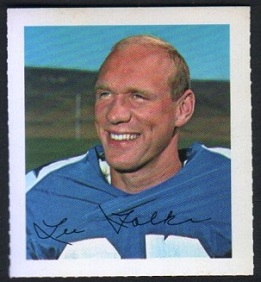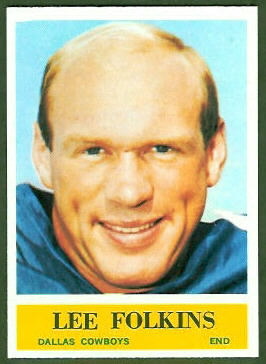A Faked Fake Autograph
April 13th, 2010 | Published in Autographs, Oddball | 2 Comments
 One of the perks of this business is that I often get notes from players’ relatives and friends. Occasionally I even hear from the players themselves. Yesterday I got an email from Lee Folkins, who played for the Packers, Cowboys, and Steelers from 1961 to 1965. What he told me was interesting: he said that the signature on his 1964 Wheaties Stamp is not his. Pictured here is the stamp in question.
One of the perks of this business is that I often get notes from players’ relatives and friends. Occasionally I even hear from the players themselves. Yesterday I got an email from Lee Folkins, who played for the Packers, Cowboys, and Steelers from 1961 to 1965. What he told me was interesting: he said that the signature on his 1964 Wheaties Stamp is not his. Pictured here is the stamp in question.
The signatures on the Wheaties Stamps are facsimiles, printed right on the stamps, but because the handwriting is different from stamp to stamp, I presumed that they were copies of the players’ actual signatures. Apparently not all of them are. This isn’t too surprising: Topps printed the stamps for Wheaties, and Topps was known to alter players’ images, even before the 1970s airbrushing era. (For some examples, see my article on the inset photos on 1962 Topps cards.) It’s not much of a stretch to go from altering images to faking simulated autographs.
I had actually wondered how Topps got signatures for all of the players in a large set, considering that they often didn’t even seem to have good photos of all the players. For at least one set, 1970 Supers, Topps didn’t even attempt to obtain the players’ real signatures: they used the same script for the facsimile signature on every card. (See my article on the 1970 Topps Super set.) For other sets–the 1964 Wheaties Stamps, for example–I suppose that they used whatever authentic signatures they had, then employees created signatures for the rest.
I don’t know much about autographs, so I did a quick internet search to see if it’s commonly known that some of the facsimile signatures on vintage cards were faked. I didn’t find anything that explicitly said so, but I did find this paragraph on thehistorybank.com:
Finally, remember that Topps’ player facsimile autographs on cards are just that—facsimiles with no intent of looking real. Interestingly, Topps put facsimile signatures on cards for years, but don’t try to “authenticate” using those signatures. They often do not match the real thing. Note here that Marshall’s and Averill’s hand-signed signatures match the facsimile signatures fairly closely, but Narleski’s ballpoint signature bears no resemblance to the printed signature on the card.
 Unfortunately, the image in the History Bank article is too small to compare the two Ray Narleski signatures, but perhaps Narleski’s ballpoint signature bears no resemblance to the printed signature because the printed signature isn’t his. An autograph collector would certainly know more about this than I do. Can anyone else provide comments or examples?
Unfortunately, the image in the History Bank article is too small to compare the two Ray Narleski signatures, but perhaps Narleski’s ballpoint signature bears no resemblance to the printed signature because the printed signature isn’t his. An autograph collector would certainly know more about this than I do. Can anyone else provide comments or examples?
Back to Mr. Folkins. Besides his Wheaties stamp, he appeared on one card that I know of: the 1964 Philadelphia card shown here. Both his stamp and card were issued the year after he made the Pro Bowl. All of the players on the 1964 Wheaties Stamps, in fact, were 1963 Pro Bowlers. You can read more about the Wheaties Stamps and accompanying album in a previous blog article.

August 14th, 2010 at 9:40 AM (#)
[…] an article in April, I wrote that Lee Folkins had told me that the facsimile signature on his 1964 Kellogg’s […]
July 4th, 2011 at 8:27 AM (#)
[…] Lee Folkins was born on July 4, 1939; his rookie card, a 1964 Philadelphia, is shown here. (I heard from Mr. Folkins once. He told me that the signature on his 1964 Wheaties Stamp is not in his handwriting.) Five-time […]